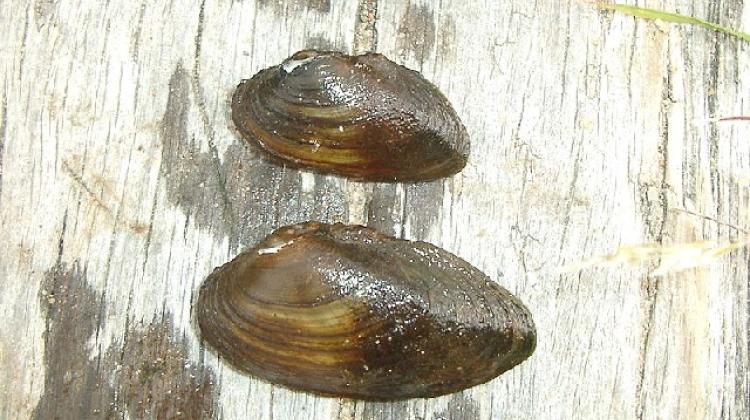Fragile life of hard mussels

Who would have thought that a mussel\'s life could be so dangerous? And yet it is! It turns out that life of river mussels - large freshwater molluscs - is not boring at all - says biologist Dr. Aleksandra Skawina from the University of Warsaw.
"Almost all the pearls in jewelry stores come from river mussels - usually those living in America or Asia" - Dr. Aleksandra Skawina from the Department of Biology, University of Warsaw said in an interview with PAP. Pearls are formed when a foreign body gets inside the mussel, and the mussel surrounds it with nacre. But such foreign objects are not the only worry of river mussel. As it turns out, for this mollusc survival is quite a feat.
"When we talk about river mussels, we mean the biggest mussels living in fresh water. After reaching adulthood, most of the swollen river mussel species have a size of 1 to almost 30 cm - counting the shell" - said Dr. Skawina, who conducts research on the mysterious and not entirely understood world of freshwater molluscs. She added that in the world there were 850 species of river mussels.
The biologist explained that in Poland the term "river mussel" it commonly used for thick shelled river mussels, painter\'s mussels and swollen river mussels, but also duck mussels and freshwater pearl mussels. "Although freshwater pearl mussels are believed to be extinct in Poland since the 1940s" - noted Dr. Skawina.
It may seem that mussel\'s life is terribly boring. How interesting could it be to leisurely spend one\'s life at the bottom of a reservoir, buried in the sediments... Well, it is not easy at all! Before it safely digs in the sediments, mussel\'s larva must take an extraordinary and dangerous journey.
HITCH A RIDE! BUT STAND ON ONE LEG!
River mussel are usually dioecious. The embryos develop in the gills of the female. When they become the larvae, or glochidia, the mussel releases them into the water. And here comes one of the biggest problems of these molluscs: glochidia are parasites - they inhabit the gills or skin of fish. From the safety of gills of a relatively static mother, tiny larvae must move to a large and agile fish. And they must do it very quickly. If a glochidium fails to find a host, it will die within a few days.
To catch a fish, mussels use a variety of tricks. Dr. Skawina said that some larvae get help from their moms. For example, mussels that live in North America (Lampsilis) have folds on the outside that resemble small fish. Larger fish, thinking it is a tasty snack, swims to the mussel and is then attacked by glochidia. Other mussels (Epioblasma) catch swimming fish in a trap - clamping serrated edges of the shell on its head. This way, glochidia gain time to attack the fish. Mussel larvae sometimes also attach to each other to mimic a worm - fish food. When the fish approaches, the small, clever parasites begin to attack.
Despite this ingenuity, only a small part of glochidia survive. Mussels can release up to one billion glochidia, and only a few of them will reach adulthood.
TRAVELLING MUSSEL
Thanks to fish, mussels, which themselves are not very agile and active, can travel great distances. They can colonize new areas and contact is possible between distant populations. In addition, mussels can efficiently avoid being carried to the sea.
With time, glochidium is surrounded by tissue of fish. Larvae have to spend a few weeks, sometimes even several months on the fish. So it is not surprising that glochidia must carefully select the host. The best are young fish, whose immune system does not know how to fight parasites. But that is not all. River mussels are even more finicky. "Sometimes a mussel from one river is not able to settle on a fish from another watercourse" - said Dr. Skawina.
After some time, juvenile mussels detach from the fish and neatly bury themselves in the sediments - at a depth reaching 50 cm. "We do not know how much time they spend there before starting adult life near the sediment surface. We have not managed to investigate that yet" - said Dr. Skawina. She explained that adult mussels usually live in the upper 10 cm of sediment in order to have access to water, from which they filter out food.
The researcher admitted that farming river mussels is very difficult - the biologist conducts her research in a lake - natural habitat of studied molluscs.
In her research Aleksandra Skawina attempts to determine how river mussels count the passage of time - for example, whether they recognize time of day or year. Because they have no eyes and live in the sediment, the answer is not obvious. And this is only one of a multitude of uncertainties related to the life of freshwater molluscs.
PAP - Science and Scholarship in Poland, Ludwika Tomala
lt/ zan/ mrt/
tr. RL
Przed dodaniem komentarza prosimy o zapoznanie z Regulaminem forum serwisu Nauka w Polsce.


















